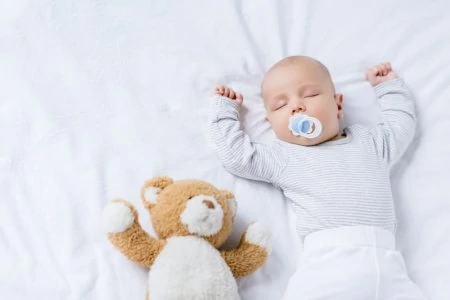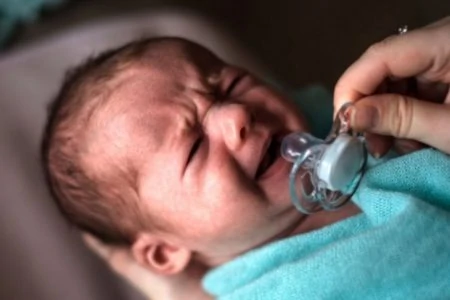Are you concerned that your baby’s pacifier is a germ trap? We share this concern. But we’ve also had babies who would only be comforted by that germ-infested binky.
So, what’s a mom to do?
We’ve researched the many ways to sterilize pacifiers, testing and comparing them to find the most effective methods.
We’re sharing our results, so you can continue soothing your baby without worrying you might be harming them.
Key Takeaways
- Sticking a pacifier in your mouth to clean it may not be as bad as it seems and may offer some protection for the baby.
- Running water can remove surface dirt but doesn’t kill bacteria.
- Boiling water is an effective method but ensure the pacifier cools down thoroughly before giving it to the baby.
- Machine, microwave, and dishwasher sterilizing are options but can be expensive or take up counter space.
- Dishwasher sterilizing takes longer than other methods and requires a backup pacifier.
Different Ways to Clean a Pacifier
There are many different ways to clean a pacifier, but some are better than others. Let’s look at some of the methods and the good, bad, and ugly about them.
Sticking It in Your Mouth
Sometimes you’ll see a mom bend over to pick up a pacifier that has dropped onto the ground.
If there’s no running water around, they’ll take matters into their own hands to clean it. They’ll put it in their own mouth and give it a tongue bath, proving once again that there’s nothing moms won’t do for their babies. We’d rather ingest germs ourselves than let them touch our babies’ lips.
But while cleaning your child’s pacifier with your own mouth doesn’t seem like a great idea, it may not be as bad as you think.
One study showed that the children of parents who cleaned pacifiers with their own mouths might have fewer instances of asthma and fewer eczema symptoms (1). The microorganisms in their parents’ mouths might offer babies some protection. But the jury is still out on this one.
If you happen to drop a pacifier, and you’re desperate, it’s worth a shot, unless you are sick at the time. Then you should keep those germs to yourself.
The Running Water Method
Putting a pacifier under a running faucet is enough to remove surface dirt, but it won’t do much for any of the stubborn bacteria and germs that cling to it. And, believe us, pacifiers contain bacteria. Even brand new pacifiers may be contaminated (2).
While running water is better than nothing, you shouldn’t assume your paci is clean just because it looks clean.
The Boiling Water Method
Many parents opt to boil their baby’s pacifiers for a few minutes to kill bacteria. This is an excellent method as long as you feel comfortable that no harmful chemicals will leach out of the pacifier during the heating process.
Take Note
Machine, Microwave, or Dishwasher Sterilizing
You can buy machines to sterilize a pacifier. The downside to this method is that sterilizers can be expensive. Plus, those clunky sterilizers will take up counter space, which is a hot commodity in every mom’s kitchen.
You can also use a microwave sterilizer, like the Philips AVENT sterilizer, to zap any bacteria.
But if you’d rather not purchase a sterilizer, you can sterilize pacifiers in the dishwasher on the top rack. The downside to this is it takes a lot longer than other sterilizing methods, so you’ll need a backup pacifier to use in the meantime. Babies aren’t known for their patience.
What You’ll Need
Depending upon which method you choose, you won’t need much, if any, special equipment for cleaning your baby’s pacifier.
Here are the few things you might want to consider having on hand.
- Dish soap.
- Dishrag or fresh sponge.
- Pan.
- Electric sterilizer.
- Microwave sterilizer.
- Plastic baggies.
How to Clean and Sterilize Your Baby’s Pacifier
It doesn’t take much brainpower, time, or concentration to fully clean and sterilize your pacifiers.
Here is what you have to do.
1. Wash Them First
Before putting them in a sterilizer, you first need to wash your baby’s pacifiers. Fill a clean sink with hot, soapy water. If your kitchen sink hasn’t been cleaned for a while, use a clean bowl instead. You don’t want to risk introducing more germs than you’re getting rid of.
Use a freshly cleaned dishcloth or new sponge as used kitchen sponges are bacteria traps (3).
2. Inspect Them
Once those pacifiers are sparkling clean, check them over to ensure they’re still in good shape. If you see any cracks, tears, or compromised parts, you need to toss them out right away.
If the pacifier nipple feels sticky after you have already washed it, it’s time to pitch it as well. That means the material is no longer in good condition, and you don’t want your baby sucking on it.
3. Sterilize Them
If you decide to boil a pacifier to clean it, heat the water to a rolling boil. Add the pacifier and boil it for five minutes.
If you’re using an electric sterilizer, follow the manufacturer’s instructions as the process is different for different units.
When using a microwave sterilizer, it’s also important to follow the instructions, so you don’t microwave the pacifier for too long.
When using the dishwasher as a sterilizing method, make sure you only put the pacifier on the top shelf of the dishwasher. The heat on the bottom rack can be too intense.
However, before using the dishwasher, ensure your pacifier brand is safe for dishwasher cleaning. Most do well in the dishwasher, but latex pacifiers may not be as dishwasher safe.
4. Let Them Dry
Let the pacifiers dry out before putting them away. They should air dry fairly quickly. You can take them by the handle and shake out any excess water to speed things along. Some sterilizers have a drying feature that takes care of this step for you, but it does take extra time.
Dry your pacifiers on a clean dish towel so you aren’t contaminating them by putting them on a dirty kitchen counter.
5. Put Them Away
To keep pacifiers clean between uses, you should put them away until needed. A good place to keep them is in a plastic Ziploc bag. They fit easily into purses or diaper bags and will prevent further contamination.













